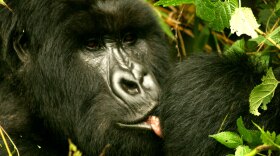Last year, a group of naturalists organized #BlackBirdersWeek: a week-long program celebrating black nature enthusiasts and scientists. With the 2nd annual #BlackBirdersWeek set to kick off on Sunday, May 30th, we decided to celebrate with some of our favorite Outside/In avian content.
In this episode, we'll hear more about how #BlackBirdersWeek was born, learn how to do our own backyard birding, and discover the strange science behind "pigeon megacities".
2nd Annual Black Birders Week
Sam Evans-Brown + Taylor Quimby
On May 25, 2020, the same day that police killed George Floyd in Minneapolis, Christian Cooper was birdwatching in the Ramble, a 36-acre semi-forested woodland in New York City's Central Park. He asked a white woman to obey the park rules and leash her dog, but she refused and called the police.
"I'm going to tell them that there's an African-American man threatening my life," she told Cooper, who recorded her on his smartphone.
The incident demonstrated how the experience of public outdoor spaces isn't the same for everyone. In an article for Citylab, Brentin Mock wrote that "peaceful green spaces just as easily induce anxiety and trauma for black and brown people, especially when they know the cops can be unleashed at any moment."
But in response to the encounter, and "the murders of Ahmaud Arbery, Breyonna Taylor, George Floyd, and the countless others," a group of naturalists under the umbrella BlackAFinStem organized #BlackBirdersWeek, a week-long program celebrating black nature enthusiasts and scientists.
This year, #BlackBirdersWeek is back with a new slate of online events that run from Sunday, May 30th, through Saturday June 5th.

"The fact that people think that racism doesn't happen in the birding community is pretty laughable to me," said Danielle Belleny, wildlife biologist and co-organizer of #BlackBirdersWeek.
"I've been followed around by people that are on trails because they think I look suspicious with my binoculars... or I've also had the cops on me while I've been working. And it's really frightening when those situations happen."
"I think birders, as a whole, are very inviting," said Belleny. "However, once you get inside the group, you do start to understand, oh yeah, this is the same racism I experienced when I was at school, or some other activity. The racism is still the same."
While #BlackBirdersWeek highlights those experiences, the organizers also aimed to elevate the joy and passion of black naturalists.
"We wanted to provide reassurance through community by reaching out and letting other people know who are maybe isolated in their interest... you have friends. We are here. Come join us, even though it's online. We definitely have a community," said Belleny.
The line-up for this year’s #BlackBirdersWeek includes panel discussions, live birdwatching opportunities, watch parties, and more.
Backyard Birdwatching
Taylor Quimby + Sam Evans-Brown
There is a kind of bird watching, or birding, where people travel all over the world to see as many types of birds as possible. It’s basically a sport, and it takes money, time-off, and a lot of bird know-how to do.
But there’s another type of bird-watching that anybody can do, from the comfort of a backyard, or even a kitchen window, without any special tools or bird expertise at all. All you need is your ears and/or eyeballs, a notebook, and maybe a couple of cardboard toilet paper tubes.
[Listen to the full audio version of this story here]
Pigeon Megacities
Justine Paradis
The northeastern United States is home to two “pigeon megacities,” according to research published last April. One city covers New York and the mid-Atlantic; the other, Providence to Boston.
In other words, New England pigeons don’t mix with the rest of the eastern seaboard.
Evidently, they’re prevented from dispersal by a swath of suburban green space in Connecticut.
“The pigeons have their own idea about what these cities look like,” said Joshua Sokol, a freelance writer who covered the research in the New York Times. “Obviously, we as people really do too. It’s just our ideas are a little bit different than the way that a pigeon sees it.”

This opens up a larger conversation about urban evolution, a field which explores how organisms are adapting to cities.
“Urban evolution is a relatively new field, for a long time we thought that evolution took millennia to happen and it was a very very slow process,” said Elizabeth Carlen, the scientist behind the research. She's an evolutionary biologist and PhD candidate at Fordham University. “About a decade ago, researchers started to realize that urban animals can actually change really quickly… a lot more quickly than we had ever thought.”
For the study, Carlen spent a lot of time searching for birds.
“I spent a lot of hours driving around cities, not seeing pigeons,” said Carlen. “We notice where pigeons are, but not where pigeons are not.”
Carlen caught pigeons using a net gun, took genetic samples, and crunched the data to determine if they were interbreeding across cities, matching up her findings with maps of impervious surfaces and light pollution maps.
“One of the biggest questions right now in our field is: how do we define urbanization? Are there different metrics that we should be using?” said Carlen.
Read more about this story at The New York Times.








